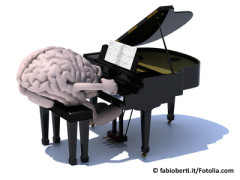If you have performed from memory, you no doubt have had the experience of an audience
member coming up after a concert and saying in amazement “How did you learn so many  notes?”
notes?”
In the last few posts about memory, we’ve talked about learning and memory as two sides of the same coin, about the many kinds of memory in music, about the formation of neural pathways in the brain, and about our brain initiating a motor-action plan as we begin to play a piece of music. But how, in fact, do we “learn so many notes,” and what are the best ways to practice to ensure that the memory for all those notes will remain secure?
We are able to learn and memorize music (or anything else) due to the brain’s ability to encode, store, and recall information, and those are the three stages that are usually talked about in connection with memory. Consolidation is sometimes considered part of encoding, sometimes part of storage, and sometimes considered separately. Since what happens in consolidation is so important in our understanding of memorizing music, we’ll consider it separately.
Encoding is the first step in memorizing music. As we encounter a new piece of music, encoding is the process of converting all of our visual, auditory, tactile, and motor perceptions into representations in the brain – representations that will eventually be turned into long-term memory. Sometimes these representations are spoken of as memory traces; in biological terms, they are the neural pathways that we discussed in the last post.
Initially, these memory traces or pathways are part of our short-term memory. If we do nothing to strengthen them, they will disappear. If we want them to become part of long-term memory, however, they must be consolidated. We practice, and as we practice, the brain consolidates these memory traces or neural pathways – strengthening, reorganizing, stabilizing, adding meaning, filling in blank spots, making connections to previous knowledge.
Think about the first time you sight-read a piece of music. You may play only the bare bones of the piece, and it won’t be totally accurate (unless you are a phenomenal sight-reader). Your brain encodes an initial memory trace of that piece. If you decide to learn it and commit it to memory, you go back to study and practice more carefully. You add details, you fix incorrect rhythms or pitches, you notice rhythmic, melodic, and harmonic patterns, you figure out the best fingering, you learn the structure, you problem-solve how to address difficult technical issues, you think about interpretation, etc., etc., etc. Your brain is consolidating the memory for this piece of music and transferring it to long-term memory.
As you continue to practice the same musical material, adjusting and refining, the neural pathways become stronger as synapses are strengthened, more neurons are recruited, new neural pathways are formed, and some neural pathways are re-routed. Transmission of the information becomes faster as increased myelin is added to axons. Remember from the last post that “cells that fire together, wire together.” So the more you practice and continue to adjust and refine, the stronger the neural pathways become, and the stronger the consolidation of memory.
Storage would seem to be a rather passive part of the memory process. After all, we don’t control where our memory of Für Elise is stored in our brain. It isn’t even stored in any one particular place. Various aspects of Für Elise are stored in different parts of the brain – our visual representation of the piece in one part of the brain, how it sounds in another part, the emotions we feel when playing it in another part, the motor plan for the piece in another, the harmonic structure in another, what our teacher told us about it in another, etc.
What we do control, and we’ll come back to this in the next post, is what we are paying attention to as we practice, because that determines what information, and how much information, is encoded and how securely it becomes consolidated and stored in long-term memory.
 Retrieval is what we count on in performance. During retrieval, the brain reconstructs all the various elements of Für Elise that are stored throughout the brain and linked by neural networks. So when we recall a piece of music from memory, we are re-visiting the neural pathways that were formed when the brain encoded the memory, and how readily we can remember the piece depends on the strength of those pathways.
Retrieval is what we count on in performance. During retrieval, the brain reconstructs all the various elements of Für Elise that are stored throughout the brain and linked by neural networks. So when we recall a piece of music from memory, we are re-visiting the neural pathways that were formed when the brain encoded the memory, and how readily we can remember the piece depends on the strength of those pathways.
But the very act of retrieving the memory of a piece of music changes it – and that is called reconsolidation. You know that the more times you play a piece from memory, the more secure you become. That’s because each time you play it from memory, you are strengthening the memory traces or neural pathways, and you are also modifying them. You think of another interpretation, another fingering, other patterns become apparent, your technique becomes more fluid, you have more experience in front of an audience so nerves affect you less. So the memory itself changes; it reconsolidates and is again stored until the next time you play it.
So that brings us to the crux of the whole discussion of memory, which is, how do we practice to ensure successful recall at the time of performance?
As an undergrad, I once played for György Sebők in a masterclass. Sebők was an internationally known pianist who was on the faculty of the Indiana University School of Music. After the class, he sat and spoke informally with several of us about what it means to be a musician, about learning to accept mistakes as long as you had played your best, about feeling rhythms in the body, and other wide-ranging topics. What has stayed with me all these years, however, were his comments about learning and practice.
He commented that no one could practice – with attention and concentration – for more than three hours a day. As students we were, of course, trying to outdo each other in number of hours a day spent at the piano. But Sebők was quite insistent that only the practice in which the mind was fully engaged did any good in terms of learning, and one could not sustain concentrated, focused practice for more than three hours a day. He went on to say that two or three hours of practice in which the mind was fully engaged and focused would do far more good than six hours of mindless repetition, as would one hour of fully engaged practice compared to three hours of simply playing the piece over and over.
Sebők made these comments well before the current research about learning and memory was known, but of course he was absolutely right. Researchers agree that it is the focus, attention, mindfulness during practice that make a difference in the strength of our learning and memory, and that the more you think and perhaps struggle while you practice, the more effective that learning will be. So what kind of practice will ensure learning and memory that are more effective – and secure?
To be continued.
7 responses to “From sight-reading to memorized performance”
I think the concept of slow practice is not often discussed. It enables substantial amounts of information to be recorded, and effectively repeated (practice) with more consistent accuracy. And the ‘magic’ is that like a tape recorder, one can still reproduce when effectively learned, at a brisker pace. Naturally the only limitation is the strength of the muscles in our our fingers, that like all muscles therefore require a regular “work out” to develop and maintain strength and coordination.
I would appreciate your comments on this. I find your material well researched and presented.
Thank you Kwame. I will talk about slow practice in the next post when I suggest different ways of practicing that have been shown to be more effective. So stay tuned!
[…] Relying on memory […]
Slow practice is a good way to think about exactly what notes you are playing, but physically it feels very different from playing fast. Playing slowly encodes different motor patterns in the brain from playing quickly. When the performer brings the piece back up to tempo, the different physical motions needed to play quickly could actually interfere with recall. Some slow practice can be good, but it’s not a magic bullet to ensure memory.
I teach my students never to learn a piece by working from the beginning – playing from the beginning of a piece straight through is called “sight-reading.” Sight-reading is not a good practice strategy, because it promotes mindless repetition! Before students learn a piece, they have to analyze it and look for patterns. They have to decide what is easy, what is difficult, and what types of practice strategies will help them with the difficult bits. I guide younger students through this process, but the older students get, the more I expect them to do this on their own. When it comes time to memorize, students already know the patterns and can start from any point in the piece. That foundation helps the memorization process tremendously!
Thanks for the input, May Lauren! – you’ve actually written about some of the things I will be talking about in the next post. And you are absolutely right about slow practice encoding different motor patterns than fast practice – we’ll talk about that. Sounds as though you are training your students in a really productive learning and memory process. It’s a more difficult way to teach, but worth the effort.
Thanks for this wonderful series of posts. You’re taking all this raw neuroscience, presenting it clearly, and then making the connections with music making. For me there’s the sense we’re coming to a tipping point of all this info being broadly and usefully incorporated into music education and music therapy – and your work is helping us get there sooner.
Brava!
Thanks so much, Lyle! As you can tell, I’m rather passionate about how to use neuroscience in a practical way for musicians, so I really appreciate your comments!!!